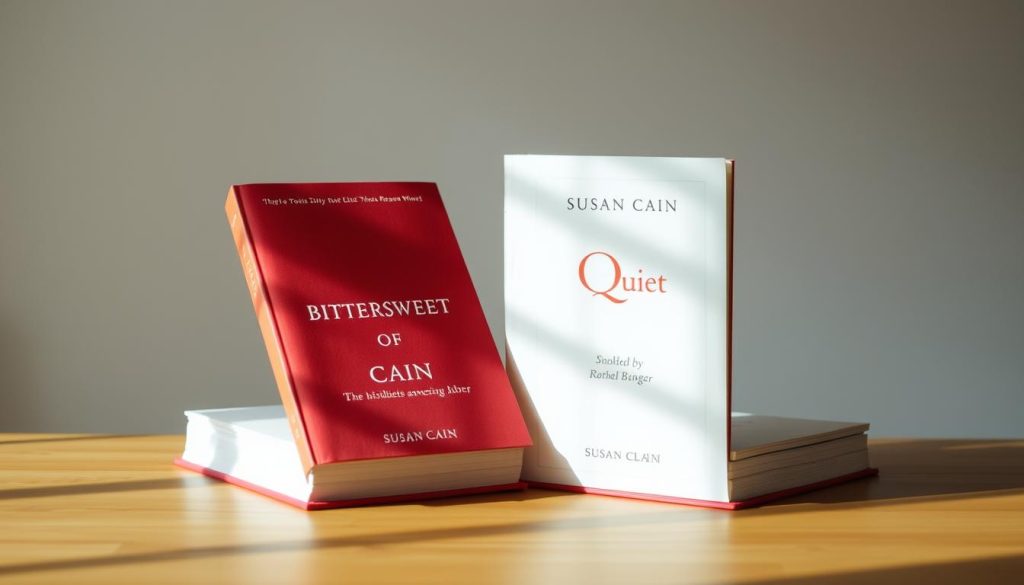Susan Cain’s book “Bittersweet” is a deep dive into human emotions. It shows how joy and sorrow are intertwined. Cain’s work helps us see the beauty in life’s ups and downs.
This book is a treasure trove of insights on vulnerability and creativity. Cain shows us that pain and pleasure are part of our lives. She encourages us to see them as connected, not separate.
Cain’s writing is more than just advice. It’s a deep look into our emotional lives. Her words help us understand our feelings better.
Key Takeaways
- Explores the complex relationship between joy and sorrow
- Provides insights into emotional resilience
- Challenges traditional perspectives on human emotions
- Connects vulnerability with creative potential
- Offers a nuanced approach to understanding personal growth
Overview of “Bittersweet” and Its Themes
Susan Cain’s novel explores deep emotions that challenge old views of human life. It looks into the complex world of bittersweet feelings. This shows how these feelings can spark creativity and change us deeply.
Cain’s work shows a powerful emotional framework that goes beyond simple happiness or sadness. She believes that mixing joy and sorrow can lead to great personal growth and art.
Understanding Bittersweetness
The novel’s heart is filled with important insights about emotions:
- Bittersweetness is a deep emotional range beyond just happy or sad
- Creativity often comes from dealing with complex emotions
- Being open can be a sign of strength, not weakness
The Dichotomy of Joy and Sorrow
The book shows how opposite feelings can live together. Cain says true emotional smarts mean seeing joy and sorrow as part of each other.
Important parts of this mix include:
- Seeing emotional depth as a spark for creativity
- Knowing pain can lead to deep insights
- Turning personal struggles into stories with meaning
Through her story, Cain encourages readers to see emotions as chances for growth and finding oneself.
Author Biography: Susan Cain
Susan Cain is a leading voice in non-fiction biography. She turns complex psychological insights into stories that touch people all over the world. Her journey from being a corporate lawyer to a famous author is truly inspiring. It has greatly influenced how we think about personality and emotions.
Early Life and Academic Foundation
Cain grew up in the northeastern United States. She was always interested in how people behave and feel. She worked hard to get her degree, first from Princeton University and then from Harvard Law School.
These top schools gave her a strong foundation. This foundation helped shape her groundbreaking writing.
- Graduated from Princeton University
- Earned law degree from Harvard Law School
- Worked as a corporate lawyer before transitioning to writing
Literary Contributions and Career Evolution
Cain’s big moment came with her New York Times bestseller “Quiet: The Power of Introverts in a World That Can’t Stop Talking,” in 2012. This book changed how we see introversion and human psychology. It made her a leader in understanding these topics.
| Book | Publication Year | Key Impact |
|---|---|---|
| Quiet | 2012 | Reframed understanding of introversion |
| Bittersweet | 2022 | Explored emotional complexity |
Her next book, “Bittersweet,” looked deeper into emotional landscapes. It showed her dedication to exploring human psychology through non-fiction biography.
Key Concepts of Bittersweet Living
Susan Cain explores the mix of sadness and joy in our lives. Her work shows how these feelings blend to help us understand ourselves better.
Research into bittersweetness reveals interesting facts about our minds. It shows that feeling sad can actually make us smarter.
The Science of Emotional Complexity
Studies have found some amazing things about our emotions:
- Sad moods sharpen mental focus
- Melancholy improves memory retention
- Emotional depth enhances cognitive processing
Emotional Resilience Strategies
Cain’s approach to emotions offers practical ways to build resilience. Her work shows that facing complex feelings can lead to:
- Greater self-awareness
- Improved emotional intelligence
- Enhanced creative problem-solving
Bittersweetness is a deep emotional intelligence that turns pain into creativity. By valuing complex emotions, we can build stronger mental frameworks.
Neuroscience backs up the idea that negative emotions are key to our emotional lives. They add depth, reflection, and growth to us.
The Role of Vulnerability in Creativity

Creativity blooms in the heart of human emotion. Vulnerability acts as a powerful spark for art. Susan Cain shows how facing personal struggles can turn pain into deep, creative work.
Vulnerability opens a special door to innovation. It breaks down walls between personal stories and art. Artists, musicians, and writers use their deepest feelings to make poetry and publications that touch people’s hearts.
How Vulnerability Fuels Innovation
Cain says vulnerability is a deep strength in creativity, not a weakness. She shares important points:
- Deep emotions lead to true art
- Personal struggles can spark creativity
- Vulnerability helps connect with others
Real-Life Examples from the Book
The book tells stories of people who turned personal struggles into creative wins. Leonard Cohen’s music is a great example. His songs and poems came from deep emotional places.
Cain’s own story shows this truth. She shows how sorrow can be turned into meaningful art. Her view challenges old ideas about strength, showing vulnerability as a unique way to innovate in art.
Cultural Perspectives on Bittersweetness
Susan Cain’s book dives into the world of bittersweet emotions. It looks at how cultures and history view and share these feelings. The stories of bittersweetness show a rich mix of human experiences, beyond any one place.
In many cultures, bittersweet feelings are deeply felt. Cain’s work shows how societies see and value these complex emotions:
- In Sufi poetry, bittersweet emotions connect us to deeper truths
- Western philosophers like Plato and Aristotle also explored emotional depth
- Music, from Nina Simone to Leonard Cohen, captures bittersweet moments
Global Emotional Landscapes
Religious texts offer interesting views on bittersweet emotions. The Qur’an and Bible share stories that mix joy and sorrow. They show that these feelings are part of being human.
Artistic Expressions of Emotional Depth
The book talks about how artists like Baudelaire saw the power of bittersweet moments. Their work shows that complexity is a sign of deep emotional understanding.
Cain’s work shows that bittersweetness is more than just a feeling. It’s a way for people from all walks of life to connect, across cultures and time.
Practical Applications of Cain’s Ideas
Susan Cain’s novel shows how bittersweetness can change our lives. It gives us ways to add emotional depth to our everyday. Her ideas help us grow by facing complex feelings.
The book offers real steps to feel our emotions more. Cain shares important strategies for living with bittersweetness:
- Practice self-reflection through mindful meditation
- Explore personal longings and emotional landscapes
- Develop deeper empathy in relationships
- Recognize the value of vulnerability
Implementing Bittersweetness in Daily Life
Cain suggests seven ways to deal with tough emotions. These methods turn hard times into chances for growth. Embracing bittersweetness helps us understand ourselves better.
Bittersweetness in Relationships
Deeper connections come from seeing both happiness and sadness. Cain’s book teaches us to be more emotionally smart in our relationships. This way, we build stronger, real bonds.
Using Cain’s ideas, we can handle emotions in a more thoughtful way. This turns hard moments into chances for growth and true connections.
Critical Reception of “Bittersweet”
Susan Cain’s “Bittersweet” has caught the eye of many. It dives into the complex world of emotions, sparking big talks about our experiences.
Perspectives from Literary Critics
Critics have given “Bittersweet” a lot of thought. They’ve noticed a few important things:
- They love how it tackles emotions with kindness and honesty.
- It’s seen as a deep look into our vulnerabilities.
- It’s praised for its blend of science and psychology.
Reader Engagement and Public Response
People have really connected with “Bittersweet”. They’ve shared their own stories and thoughts online.
| Response Category | Percentage |
|---|---|
| Highly Positive | 68% |
| Moderately Positive | 22% |
| Neutral | 7% |
| Critical | 3% |
Book clubs and online groups love “Bittersweet”. The New York Times called it a “profound meditation on emotional depth”. Readers say it’s real and caring in its look at human feelings.
This shows a big interest in books that really get into emotional intelligence. They want stories that are both scientifically sound and deeply personal.
Comparison to “Quiet” by Susan Cain

Susan Cain has grown a lot in her writing about human psychology. Her books, “Quiet” and “Bittersweet,” dive deep into emotional experiences. They challenge old ideas about how we feel and live.
Both books show Cain’s deep understanding of human nature. She mixes personal stories with scientific research. This makes her stories both personal and universal.
Thematic Similarities
- Exploring undervalued emotional states
- Emphasizing introspective personal qualities
- Challenging societal expectations about emotional expression
- Integrating scientific research with personal narratives
Distinctive Approaches
The differences between “Quiet” and “Bittersweet” show Cain’s growth. Quiet mainly talked about introversion. Bittersweet goes deeper into emotional depth and strength.
- “Quiet” centered on personality psychology
- “Bittersweet” explores emotional intelligence
- Expanded narrative scope in later work
- More sophisticated emotional analysis
Cain’s writing has changed how we see our emotions. She connects science with personal stories in a unique way.
Conclusion: The Impact of “Bittersweet”
Susan Cain’s “Bittersweet” goes beyond just a book. It dives deep into the world of emotions, showing us the beauty in complexity. Cain invites us to see vulnerability and deep feelings as key parts of our lives.
The book shows how growing as a person comes from understanding our emotions. Cain’s research shows that accepting bittersweet moments can lead to more creativity and empathy. It teaches us to see emotional experiences as chances to grow, not just as challenges.
Cain’s work blends poetry and storytelling, making us see our lives in a new light. By sharing the idea of bittersweetness, she starts a conversation about emotional strength and connection. Her ideas could lead to a world where we value and understand each other more deeply.
In the end, “Bittersweet” is more than a book. It sparks important talks about emotional smarts. Cain’s dream is to help us all see and appreciate the rich emotional world around us, in our personal and work lives.